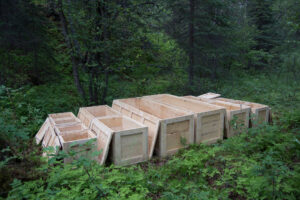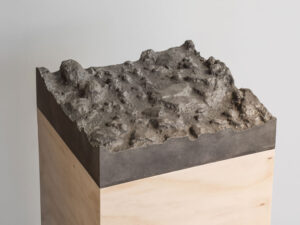Chair, Department of Creative Arts
Professor of Art
Education
Rhode Island School of Design
Masters of Fine Arts, Sculpture - with Honors (2009)
New College of Florida
Bachelor of Arts, Visual Art - Sub-concentration Biology/Chemistry (2002)
About
Kelly Goff is an artist with a focus on sculpture, installation, and public projects. His materials and processes are broad in range, reflecting a love of technology in formats that span from traditional to emerging. Examples include hand-building techniques in wood, metal, and stone; mold-making and the casting of plastic, foam, and concrete; large-scale structural papier mache; hydrographic printing, photogrammetry (creating virtual models from composite photography); sculpturally embedded video and video installation, 3D printing and CNC fabrication processes.
Goff is also a dedicated traveler and much of his work is informed by research excursions and residencies domestic and abroad including work done in Key West, FL, the Alaskan wilderness, Bhutan, Nepal, the Ecuadorian Amazon, and in his homeland, the Caribbean island of Curaçao.
Professor Goff’s work has been exhibited widely including public sculpture commissions across the country and in South Korea as well solo exhibitions at the Boston Children’s Museum and Bromfield Gallery in Boston and group exhibitions in New York City at the Governor’s Island Art Fair, Work Gallery, Davidson Contemporary, and Galapagos Art Space. He is the recipient of a Massachusetts Cultural Council Artist Fellowship; St. Botolph Club Foundation Grant; full fellowship for Residency at the Chulitna Lodge Residency, Lake Clark Alaska; a full fellowship for residency at the Vermont Studio Center; and an Andrew W. Mellon Research Award, among others.
Professor Goff teaches courses in sculpture and design including: 3D Design, Sculpture I, Sculpture II, Public Art, First-Year Experience courses, Senior capstone courses.
Artistic Statement
My childhood home on the island of Curaçao stood within one mile of three landmarks that have influenced me profoundly: The endless and transparent Caribbean Sea, the largest drydock in the Caribbean, and a massive petroleum refinery. The juxtaposition of human industry within the natural world was palpable to me even as a child. The colorful stacks of containers in the drydock and parade of freightliners being fueled and repaired were beautiful yet menacing. I could smell the pollution from my house. I escaped to the ocean to swim and snorkel. I’d stare at the horizon and sometimes I’d spot a disappearing container ship. I never fathomed the vast network of ships crossing paths out there or how those vessels and the goods they carried are driven by and produced with oil, some of it refined in my backyard in a process that threatened my ocean.
As an adult, I’ve devoted much of my artistic practice to decoding these contradictions, like that beautiful ocean and the greasy film of oil floating on its surface in our harbor. I do this by studying and manipulating specific objects. The freight container for instance is iconic for me. It is omnipresent in my homeland and as a symbolic object, it embodies the breadth of my conceptual and visual interests. I have questions about entropy, waste, displacement, and the pressures of resource extraction in our global economy, which affected me as a child in my industrial Curaçao, which I now endeavor to understand more clearly.
Art Works
Art Works
Crates, 2014

Crates, 2014
In the summer of 2014, I embedded myself in the Alaskan wilderness for a six-week artist residency 180 miles removed from the nearest road. I discovered there a place of obvious dualities (like Curaçao) where the majestic environment is permeated with the presence of oil, from offshore rigs that fleck the landscape to the myriad of fuel types needed to power the off-grid residency and the tools I used, to the resources required to extract the sculpture I made on site.
With this tension as context, I conceived of and produced a project about shipping. Using rudimentary technologies, I felled and processed dead standing trees by hand. I produced rough boards with a hand-held chainsaw mill and used the lumber to construct a series of large shipping crates. The crates are empty, except for themselves, nesting within each other like matryoshka for transport which was accomplished via fishing boat across a lake, multiple single-engined plane trips, a jumbo jet, and then UPS trucks across the country for exhibition. During this remote residency and production of Crates, 2014, I recorded audio samples. After the residency, I collaborated with the composer Ben Wasserman to produce an accompanying musical work entitled Passage, 2014, which loosely tells a story of remoteness, construction, and journey.
Souvenir I, 2018

Alaskan timber, harvested and processed at its origin.
In the spring of 2017, I was in residence in the Himalayan country of Bhutan for four months. I completed an exhausting alpine trek known as Daga La (Thousand Lakes) over four days with support from companion trekkers and Bhutanese guides and horses to reach the summit above 15,000 feet. I encountered a powerful landscape and one spot in particular that I found hard to forget—a place like a rocky alien planet. Having worn out my knee on the descent, I returned to the exact coordinates of this terrain several weeks later via chartered helicopter with helpers and equipment to create a high-resolution scan of the rocky ground. Back in the States, I used the scan data and a CNC milling machine to create a small-scale replica of the ground terrain (carved at first from rigid foam which I then translated into a wax copy) which was finally cast in bronze with a silver nitrate patina.
Souvenir I commemorates a rarely-accessed, specific patch of ground on a mountain top and is as such, akin to the old tradition of bronzing baby shoes. The sculpture also attempts something futile, to capture with the utmost accuracy a changing landscape and one person’s experience of it.
